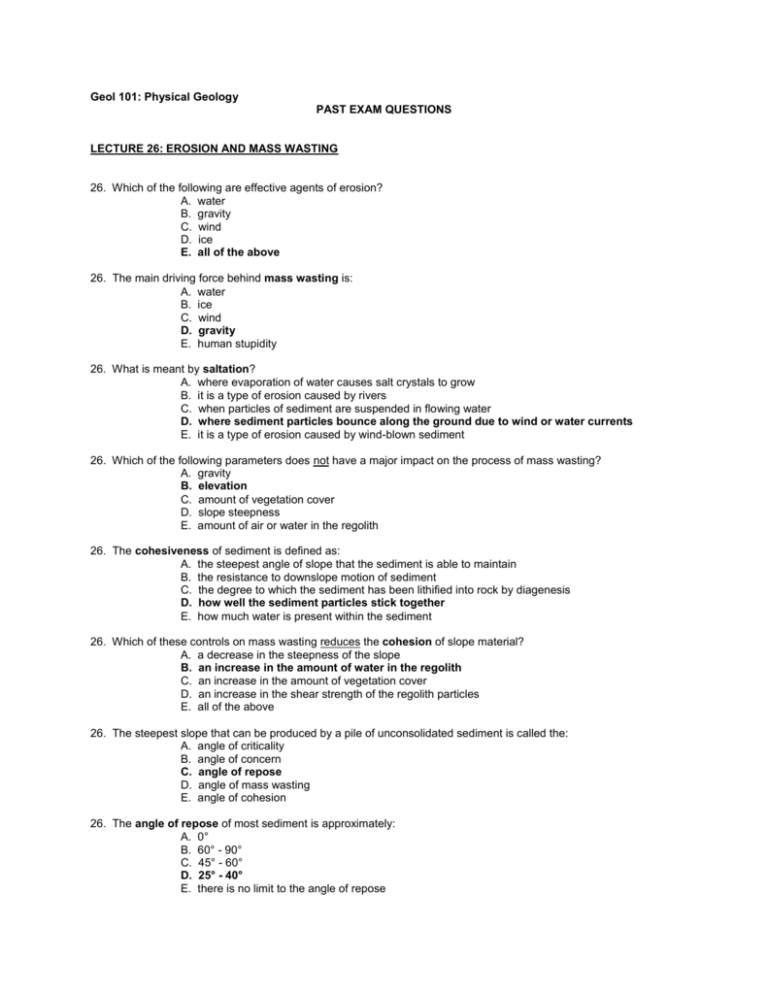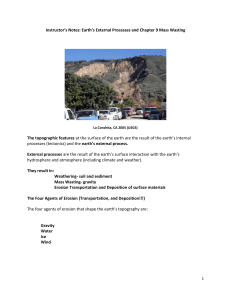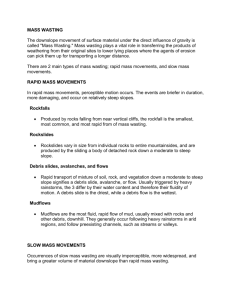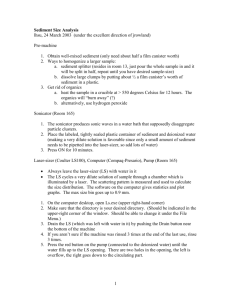Word
advertisement

Geol 101: Physical Geology PAST EXAM QUESTIONS LECTURE 26: EROSION AND MASS WASTING 26. Which of the following are effective agents of erosion? A. water B. gravity C. wind D. ice E. all of the above 26. The main driving force behind mass wasting is: A. water B. ice C. wind D. gravity E. human stupidity 26. What is meant by saltation? A. where evaporation of water causes salt crystals to grow B. it is a type of erosion caused by rivers C. when particles of sediment are suspended in flowing water D. where sediment particles bounce along the ground due to wind or water currents E. it is a type of erosion caused by wind-blown sediment 26. Which of the following parameters does not have a major impact on the process of mass wasting? A. gravity B. elevation C. amount of vegetation cover D. slope steepness E. amount of air or water in the regolith 26. The cohesiveness of sediment is defined as: A. the steepest angle of slope that the sediment is able to maintain B. the resistance to downslope motion of sediment C. the degree to which the sediment has been lithified into rock by diagenesis D. how well the sediment particles stick together E. how much water is present within the sediment 26. Which of these controls on mass wasting reduces the cohesion of slope material? A. a decrease in the steepness of the slope B. an increase in the amount of water in the regolith C. an increase in the amount of vegetation cover D. an increase in the shear strength of the regolith particles E. all of the above 26. The steepest slope that can be produced by a pile of unconsolidated sediment is called the: A. angle of criticality B. angle of concern C. angle of repose D. angle of mass wasting E. angle of cohesion 26. The angle of repose of most sediment is approximately: A. 0° B. 60° - 90° C. 45° - 60° D. 25° - 40° E. there is no limit to the angle of repose 26. Which of the following slopes is the highest possible angle of repose for loose regolith? A. 90º B. 60º C. 40º D. 25º E. 5º 26. The two categories of mass wasting are “Slides and Falls”, and “Sediment Flows”. An example from the “Slides and Falls” category is a (1) __________ and an example of a “Sediment Flow” is a (2) ___________. A. (1) debris flow (2) rockslide B. (1) solifluction (2) debris fall C. (1) debris avalanche (2) earthflow D. (1) slump (2) creep E. (1) mudflow (2) rock fall 26. The type of landslide that involves slow sliding of sediment above a concave slip surface is called: A. a slump B. a rock slide C. a mudflow D. a debris avalanche E. creep 26. All air-saturated sediment flows are called (1)________ whereas all water-saturated sediment flows are called (2)_________: A. (1) granular flows (2) slurry flows B. (1) granular flows (2) mudflows C. (1) debris flows (2) slurry flows D. (1) slurry flows (2) viscous flows E. (1) slurry flows (2) granular flows 26. What ultimately triggered a massive landslide in Peru in 1970 that killed 25,000 people in the town of Yungay? A. road construction B. removal of vegetation C. heavy rainfall D. river erosion E. an earthquake 26. The type of landslide that involves a slurry flow of clay-sized sediment is called: A. a slump B. a rock slide C. a mudflow D. a debris avalanche E. creep 26. Which of the following types of landslides is a type of slurry flow? A. slump B. rock slide C. mudflow D. debris avalanche E. creep 26. The type of mass wasting that involves the development of bulging lobes on a vegetated slope is called: A. creep B. earthflow C. solifluction D. a debris slide E. a lahar








